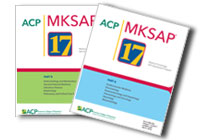 MKSAP has been trusted by internists since 1967 as the best resource for updating knowledge. MKSAP 17, available in Complete, Digital, and Print packages, consists of 11 comprehensive text chapters with related multiple-choice questions. You'll find 1,200 completely new questions to help you identify learning gaps, stay current, and gain the knowledge you need to provide the best possible patient care. MKSAP 17's original and high-quality questions evolve out of case studies and patient scenarios based on the latest evidence.
MKSAP has been trusted by internists since 1967 as the best resource for updating knowledge. MKSAP 17, available in Complete, Digital, and Print packages, consists of 11 comprehensive text chapters with related multiple-choice questions. You'll find 1,200 completely new questions to help you identify learning gaps, stay current, and gain the knowledge you need to provide the best possible patient care. MKSAP 17's original and high-quality questions evolve out of case studies and patient scenarios based on the latest evidence.
For more information on MKSAP 17, or to order your copy, visit mksap17.acponline.org
MKSAP 17 Q & A
A 68-year-old man is evaluated for a 3-month history of pain on the superior aspect of the right shoulder. The pain developed insidiously and has progressively worsened. He reports no trauma or other symptoms. Medical history is unremarkable. The patient has tried both acetaminophen and ibuprofen, with only minimal pain relief.
On physical examination, the patient is afebrile, blood pressure is 134/84 mm Hg, pulse rate is 92/min, and respiration rate is 16/min. BMI is 28. The right shoulder is normal in appearance. Pain is reproduced with adduction of the right arm across the body. The painful arc test and drop-arm test are negative. There is full active and passive range of motion; strength is 5/5 throughout the right arm. The remainder of the examination is unremarkable.
Which of the following is the most likely diagnosis?
A: Acromioclavicular joint degeneration
B: Adhesive capsulitis
C: Rotator cuff tear
D: Supraspinatus tendinitis
Click here for the answer and critique.
Back to the March International Newsletter

